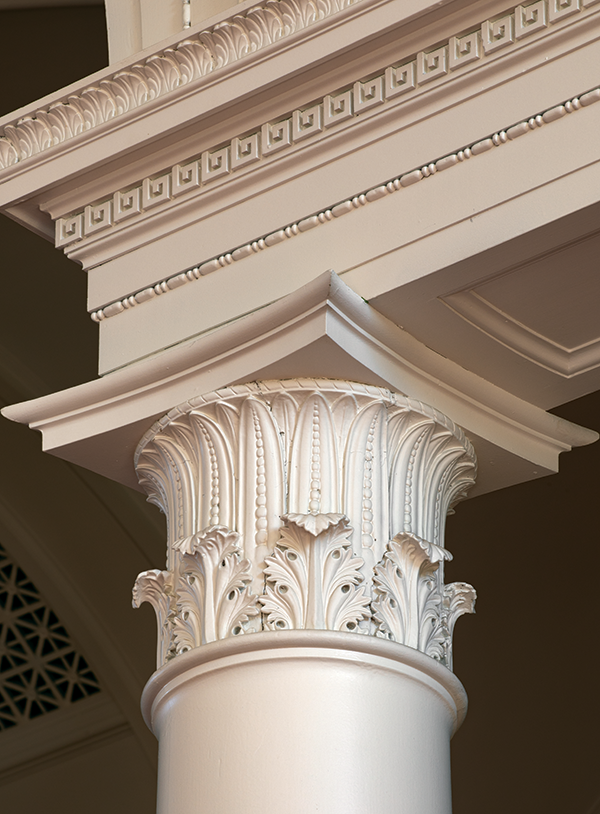An excerpt from Amherst College: The Campus Guide, by architecture critic Blair Kamin ’79

In Johnson Chapel, careful observers will notice agricultural motifs, such as stylized ears of corn.
Johnson Chapel’s noble character belies the ignoble circumstances that attended its birth.
The young Amherst College needed a chapel because its students had been unwelcome guests at an old parish meetinghouse. So the leaders of the impoverished institution turned for financial support to an unlikely patron: Adam Johnson, an aging, wealthy and (crucially) childless farmer from nearby Pelham who had no connection to the College. As Johnson, about 70 years old, neared death, the Amherst lawyer Samuel Fowler Dickinson, grandfather of Emily Dickinson, promised him a measure of immortality: a new college chapel, endowed by Johnson, would forever bear his name.
With Johnson’s assent, Dickinson in February 1823 drew up a will that designated the College as the chief heir to Johnson’s fortune. After Johnson died that August, his brother Thomas contested the will in court, claiming that Amherst had taken advantage of “a man in his dotage and mentally unfit to know how to dispose of his property rightly,” the Springfield Republican reported in 1927, on the occasion of the chapel’s centennial. But in 1826, Massachusetts’ supreme court ruled in the College’s favor, and Amherst received $4,000, enabling construction, already underway, to continue.
A skilled practitioner of Greek Revival, Capt. Isaac Damon of Northampton was probably the chapel’s architect, although the extent of his contribution is unknown. The exterior takes Greek Revival simplicity to the limit. Its western façade, a stark temple front supported by four massive tapering Doric columns fashioned from vertical strips of wood, bears a striking similarity to other Damon-designed churches. The two-tiered tower, set back from the front, has a belfry in the lower stage and an upper stage with clock faces that were added later.
There is some decoration—quoins accentuate the corners of the tower’s lower tier, and fleur-de-lis-like frilliness surrounds the clock—but the overall effect is one of powerful severity: sound proportions, simple shapes, resonant clarity. The absence of a conventional steeple renders the building more secular than sacred—and, thus, more welcoming to non-Christians.
Careful observers will notice agriculture motifs. The upper portions of the Ionic columns that support the balcony are represented as large leaves—perhaps a reference to the tobacco farms of the Connecticut River Valley. In the Corinthian columns at the front of the room, carved versions of acanthus leaves are surmounted by another reference to the valley’s agricultural bounty—stylized ears of corn.
The exquisite refinement of this detail reflects the hand of McKim, Mead & White, which remade the chapel’s east side in 1933 and 1934 under the direction of James Kellum Smith, class of 1915. The east-facing exterior, once a blank-walled brick eyesore, received a handsome new cladding of Pelham gneiss, four monumental pilasters and a proper pediment. It thus became a fitting presence along the main quad—a second front, not a back.
For years, the College required attendance at chapel services, and students rang the chapel’s 1,200-pound bell, a gift of McKim, Mead & White’s William R. Mead, class of 1867. But the services ceased in 1968, and electronic bells eventually were introduced. A room originally dedicated to the ritual of daily worship now serves as a forum for College leaders and visiting speakers. Once, it could host the entire student body; now, less than a third of the College can fit within its walls. Still, if one room says “Amherst,” this is it.
Photographs by Ralph Lieberman